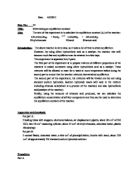Objective To find out the equilibrium constant, Kc, for the reaction below, using acid hydrolysis:
Determining an Equilibrium Constant
Objective
To find out the equilibrium constant, Kc, for the reaction below, using acid hydrolysis:
Principle
Although the hydrolysis of ethyl ethanoate is very slow, by using dilute hydrochloric acid as catalyst, the above equilibrium can be attained in 48 hours. After 48 hours, the reaction mixture can then be titrated with standard sodium hydroxide solution. Finally, the equilibrium concentrations of four components below and hence, Kc of hydrolysis of CH3COOCH2CH3 can then be calculated:
Chemicals
2M HCl, 1.0335M NaOH, ethyl ethanoate, phenolphthalein indicator
Apparatus
5 small reagent bottles, 5ml pipette & filler, burette, measuring cylinder, conical flask, electronic balance, stand, white tile
Procedure ── Preparation, allow reaching equilibrium position
1.> Label 5 reagent bottles & their stoppers as 1A, 1B, 2, 3 and 4.
2.> Weigh each reagent bottles with their stoppers and record their corresponding masses in Table 3.
3.> Pipette 2M HCl into each bottles, using measuring cylinders to transfer ethyl ethanoate into bottles 2,3,4 and water into bottles 3,4 according to the
amount shown in Table 1.
Table 1 shows the amount of chemicals added:
4.> Record the total mass before and after each addition of chemical into Table 3.
5.> Set them aside for at least 48 hours and shake the bottles occasionally.
Procedure ── Titration (48 hours later)
1.> Rinse and fill a burette with standardized NaOH solution.
2.> Pour the contents of bottle 1A into a conical flask and rinse the bottle with deionized water.
3.> Add 2 - 3 drops of phenolphthalein indicator and titrate the mixture with standardized NaOH solution.
4.> Repeat steps 2 - 3 for other regent bottles. The results are recorded in Table 2.
Table 2 shows the results of titration:

This is a preview of the whole essay
Teacher Reviews
Here's what a teacher thought of this essay
This is a very descriptive, well through out practical. It contains advanced mathematical analysis for an A2 course and draws good conclusions This piece of work is 5 stars out of 5







